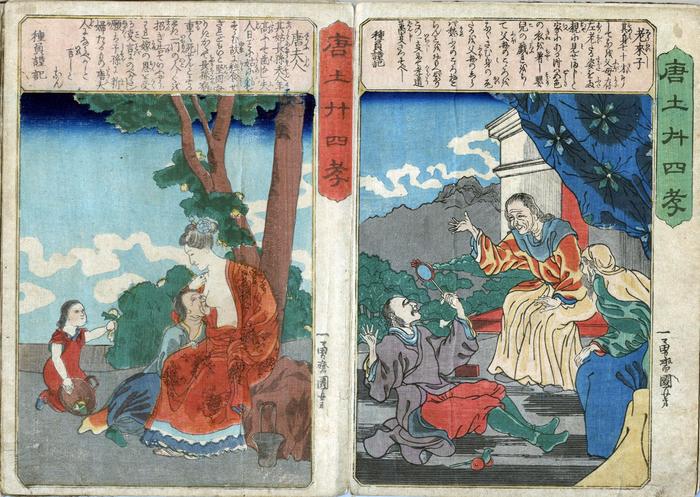Utagawa Kuniyoshi (歌川国芳) (artist 11/15/1797 – 03/05/1861)
Tō-fujin (唐夫人) on the left and Rō Raishi (老來子) on the right from the series The Twenty-four Chinese Paragons of Filial Piety (Morokoshi nijūshi-kō - 唐土廾四孝)
1847
13.5 in x 9.5 in (Overall dimensions) Signed: Ichiyūsai Kuniyoshi ga
一勇斎国芳画
Inscription: Ryūkatei Tanekazu
Kuniyoshi Project
Tokyo Metropolitan Library - right panel
Tokyo Metropolitan Library - left panel
Museum of Fine Arts, Boston - right panel
Museum of Fine Arts, Boston - left panel
Museum für angewandte Kunst, Vienna - left panel
Museum für angewandte Kunst, Vienna - right panel
Musées Royaux d'Art et d'Histoire (via Ritsumeikan University) - left panel only -trimmed
Musées Royaux d'Art et d'Histoire (via Ritsumeikan University) - right panel only -trimmed
Art Institute of Chicago - right panel
Art Institute of Chicago - left panel Below is R. Keller Kimbrough's translation of an early edition of the Nijūshikō. It does not specifically apply to these Kuniyoshi prints except in the most general terms.
[8] Old Raishi 老萊子 (Lao Laizi)
Frolicking, dancing, playing the fool;Old Raishi was a man who served his parents. Thus, when he was seventy years old, he would wear pretty robes so that he resembled a child. Dancing and frolicking, he would attend to his parents’ needs, and he would purposely trip and fall and then cry like a baby. Why? Because having reached the age of seventy, his looks were marred by age, and he feared that upon seeing him, his parents would lament that he had grown so very old. In addition, people say that he did this so that his parents would not notice their own advancing years.
a spring breeze rustles his colorful robes.
His parents open their mouths and laugh;
their room is filled with joy.
Kimbrough noted that the name Old Raishi is written with characters that can mean, “old [man] becomes a child.”
[10] Tō no Bujin 唐夫人 (Tang Furen, “Madam Tang”)
Filial and reverent, the Sai family bride:Tō no Bujin’s mother-in-law, Chōson Bujin 長孫夫人, was very old. Because she could not chew food, Tō no Bujin would feed her from her breast. In addition, every morning she combed her mother-in-law’s hair. She served her well in other ways, too, caring for her for many years. One time, Chōson Bujin fell ill and thought that she would die. She gathered together all the household and said, “To die now without repaying my years of debt to Tō no Bujin fills me with regret. If my descendants emulate her filial rectitude, then the family is sure to prosper.” Everyone praised Tō no Bujin’s devotion, remarking that there had been few in the past or present who had been so filial to their mothers-in-law. People say that for this reason the family immediately received its reward, flourishing in a most extraordinary manner.
she breastfeeds her mother-in-law, and grooms her for the day.
It is a debt that cannot be repaid;
one asks that her descendants will do the same.
****
The text below was composed by Ryūkatei Tanekazu (柳下亭種員: 1807-58).
The text on the panel on the right reads: 老來子(ろうらいし) 其身(そのみ)七十才(さい)にしてなを父母(ふぼ)存左(よにあり)老たる姿(すがた)を両親(ふたおや)に見(み)せまじと家(いへ)にある時は五色(ごしき)の衣(きぬ)を着(ちやく)し嬰兒(みどりこ)の戯(たはむ)れをなして父母(ふぼ)のこゝろをなぐさむ身(み)の老(おい)たるを父母(ふぼ)のしらば愁(うれ)ふるのこゝろおこらんことをおもへばなりこの一?(いちじ)にて孝道(かうだう)萬?(ばんじ)さつすべし 種員謹記
The book entitled The Twenty-four Paragons of Filial Piety was written by the Chinese scholar Guo Jujing during the Yuan Dynasty. His pen name was Yizi, and he is known in Japan as Kaku Kyokei. The book recounts the self-sacrificing behavior of twenty-four sons and daughters who go to extreme lengths to honor their parents, stepparents, grandparents, and in-laws. Many of the images in this series appear Western in style, rather than Japanese, and were probably copied from Italian prints. The prints in this edition appear to have been printed two per ōban sheet (about 9.5 x 13.5 inches) and folded to chūban pages (about 9.5 x 6.75 inches). The were once bound together in an album.
Japanese name: Tō-fujin
Chinese name: T’ang Fu-jēn
Tō-fujin (also known as wife Tang) suckled her toothless grandmother at her breasts.
Robinson: S60.10
Japanese name: Rōraishi
Chinese name: Lao Lai Tzu
At age 70, Rōraishi still dressed and behaved like an infant to amuse his senile parents.
Robinson: S60.8
[The above English-language information is all taken directly from the Kuniyoshi Project.]
The text of the panel on the left reads: 唐夫人(とうふじん) 其姑(そのしうとめ)長孫夫人(ちやうそんふじん)年高(としたか)ふして歯(は)なし夫人(ふじん)日ごとに姑(しうとめ)に乳(ち)をすゝむ故(ゆゑ)に粒食(りうしよく)せざれどもいと堅固(けんご)なりきかくて長孫(ちやうそん)病(やまひ)重(おも)く死(し)せんとするとき一門(いちもん)の人(ひと)ゞを招(まね)ぎ告(つげ)ていふやうわれ嫁(よめ)の恩(おん)を受(うく)る?(こと)言(ことば)にのべがたし願(ねがはく)は子孫(しそん)に新婦(よめ)たるもの唐夫人(とうふじん)にならべかしと言(いひ)しとなん 種員謹記
Historical - Social - Ephemera (genre)
Fushimiya Zenroku (伏見屋善六) (publisher)
Ryūkatei Tanekazu (柳下亭種員 - 1807-58) (author)
Nijūshikō (二十四孝: The twenty-four filial exemplars) (genre)
